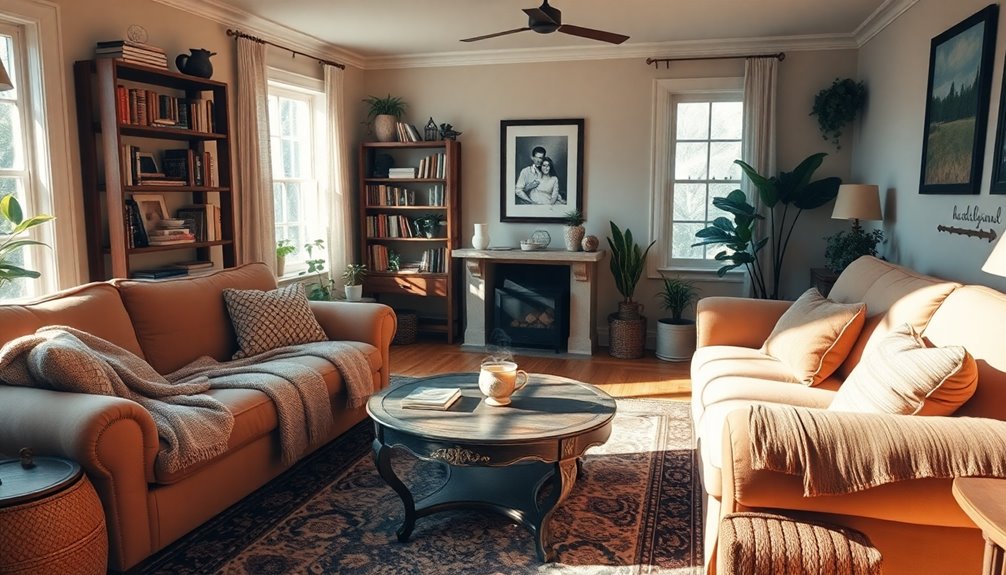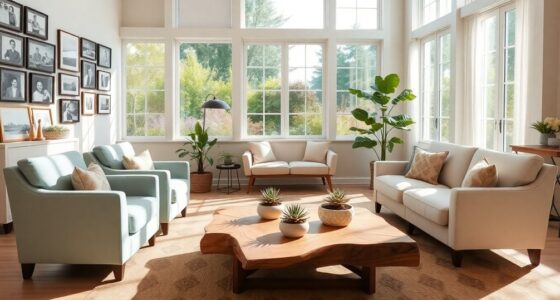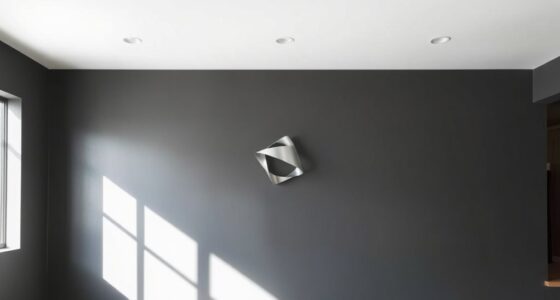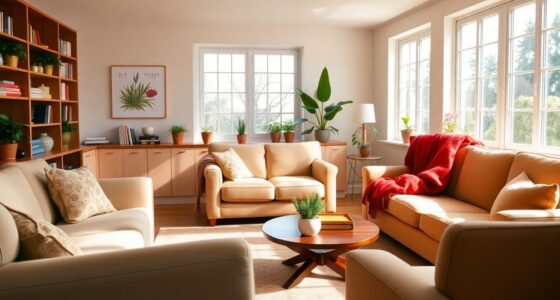To create a cozy and stylish elderly home, prioritize comfort and safety with ergonomic furniture that supports mobility. Optimize lighting for visibility and install non-slip flooring to reduce fall risks. Smart storage solutions keep clutter at bay, while technology can enhance security and convenience. Incorporate soothing colors and natural elements to uplift mood. Also, plan for future mobility needs to adapt your space. Discover more essentials to perfect your senior living environment as you go along!
Key Takeaways
- Prioritize ergonomic furniture with sturdy support and proper heights to enhance comfort and safety for elderly residents.
- Incorporate adjustable lighting and motion sensors to create well-lit spaces that reduce fall risks and improve overall accessibility.
- Use multi-functional furniture and easy-access storage solutions to optimize space while ensuring organization and ease of use.
- Personalize the environment with cherished family photos and calming colors to foster a sense of belonging and promote relaxation.
- Implement smart home technology for enhanced independence, security, and convenience, making daily tasks easier and safer.
Importance of Comfort and Safety in Senior Living Spaces
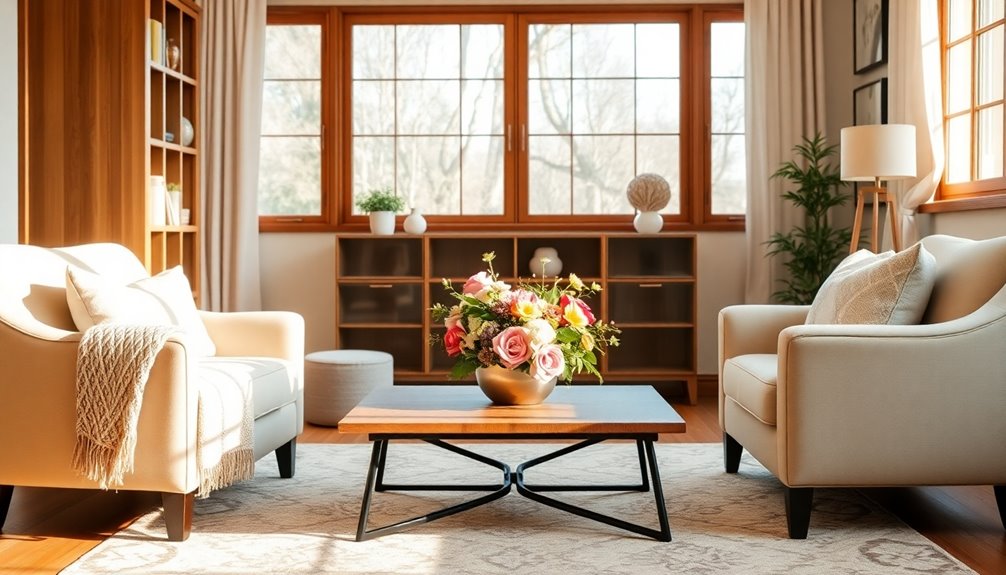
When designing a living space for seniors, it's vital to prioritize comfort and safety to enhance their quality of life.
Choosing ergonomic furniture guarantees that seating provides sturdy support and is at the right height, making it easier for them to rise and stay comfortable. Additionally, ensuring clear communication about the layout can help seniors feel more at ease in their surroundings. Incorporating family-friendly environments can also create a welcoming atmosphere that encourages social interactions.
Implementing grab bars in bathrooms and hallways greatly reduces the risk of slips and falls, promoting independence.
Clear pathways and adequate lighting are important; well-lit spaces improve visibility, making navigation safer, especially during the night.
Personal touches like familiar decor foster emotional well-being, creating a sense of belonging. Additionally, incorporating expert advice on layout and design can significantly improve functionality and accessibility in the home.
Furniture Selection for Accessibility and Support
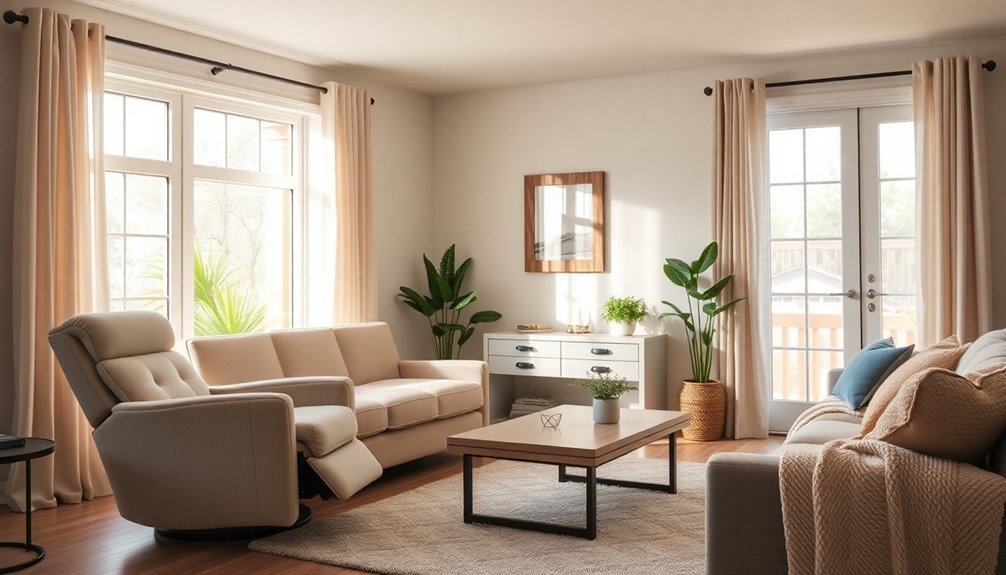
When you choose furniture for seniors, prioritize ergonomic designs that offer both comfort and support. Look for sturdy seating with armrests and firm cushions to make sitting and standing easier. Additionally, easy-access storage solutions can help reduce strain and keep the space organized. Incorporating durable materials can enhance both functionality and longevity in the living space. Furthermore, creating a cozy environment can significantly improve emotional well-being, especially for those experiencing dementia or Parkinson's. It's important to consider financial considerations for elderly care, as these factors can influence the type of furniture that is affordable and practical for seniors.
Ergonomic Furniture Choices
Choosing ergonomic furniture is essential for creating a comfortable and accessible environment for seniors. Look for pieces that provide proper lumbar support, helping to maintain comfort during long periods of sitting. Additionally, incorporating home security systems can enhance safety and provide peace of mind for seniors living alone. Many of these systems offer user-friendly installation options, making them accessible for seniors and their families.
Chairs with sturdy armrests make it easier for seniors with mobility challenges to shift between sitting and standing. Adjustable beds are another great option, allowing you to tailor the height for easy access and accommodate any medical needs.
When selecting tables and chairs, verify they're the right heights to prevent strain while moving in and out of seating. Consider multi-functional furniture, like nesting tables or storage ottomans, which optimize space while enhancing safety and accessibility. Additionally, incorporating eco-friendly materials in your furniture choices can further promote a healthy living environment.
This way, you'll create a truly comfortable living environment for your loved ones.
Sturdy and Supportive Seating
Ergonomic furniture lays the groundwork for a comfortable living space, but sturdy and supportive seating takes it a step further.
Choose chairs with sturdy armrests and firm cushions to assist in sitting and standing, which enhances mobility and comfort. Look for options that provide proper lumbar support, alleviating discomfort and promoting good posture essential for overall well-being. Additionally, various sleep training methods can help create a peaceful environment that supports relaxation and comfort. Investing in top rated vacuums can also enhance cleanliness, contributing to a healthier living space for seniors.
Adjustable beds are a fantastic choice, allowing for various heights, making it easier for seniors to get in and out without straining. Confirm that all seating and tables are at a proper height, enabling easy access without excessive bending or reaching. Additionally, incorporating moisture-resistant materials can enhance durability and ease of maintenance in seating options.
Easy-Access Storage Solutions
Creating an organized space that prioritizes accessibility can markedly enhance daily living for seniors. By implementing easy-access storage solutions, you can guarantee frequently used items are within reach, promoting independence and reducing mobility challenges.
Here are some practical ideas:
- Use easy-to-open drawers and pull-out shelves for effective organization.
- Install open shelving systems for better visibility and accessibility.
- Choose multi-functional furniture, like ottomans with storage compartments, to keep spaces clutter-free.
- Opt for lightweight, portable storage bins for easy access and transport of personal items. Incorporating non-toxic large houseplants can add a refreshing touch while ensuring a safer environment for seniors with pets. Additionally, utilizing vintage or distressed furniture can enhance the cozy aesthetic of the home while providing functional storage options.
These solutions provide flexibility in your living space while making it easier to locate and retrieve essentials without unnecessary strain. Additionally, incorporating functional layout principles ensures that the overall design is both practical and aesthetically pleasing.
Prioritizing accessible storage options leads to a more comfortable and stylish elderly home.
Optimizing Lighting for Enhanced Visibility
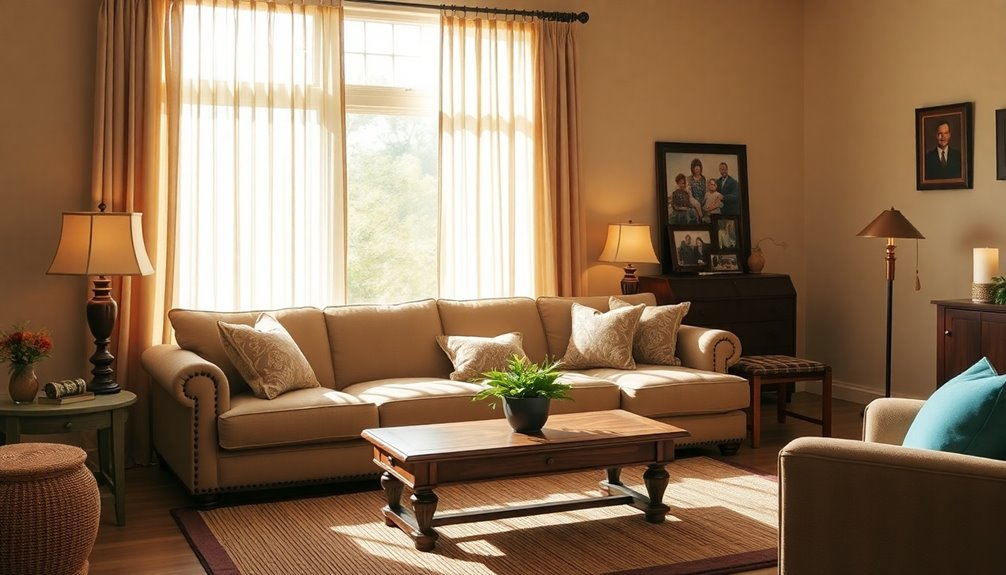
How can you guarantee that your home remains a safe haven for seniors? Start by optimizing lighting to create well-lit spaces, especially in entry points and high-traffic areas. This enhances visibility and minimizes the risk of falls.
Take advantage of natural light by positioning seating to soak up daylight, which not only brightens the atmosphere but also offers health benefits. Install adjustable lamps in reading nooks and kitchens to provide focused lighting for specific tasks.
Additionally, incorporate motion-sensor lighting in hallways and bathrooms to ascertain accessibility during nighttime trips, reducing the chance of accidents. Consistent lighting throughout your home will eliminate shadows, assuring a safer living environment for seniors, where they can navigate comfortably and confidently.
Smart Storage Solutions to Minimize Clutter
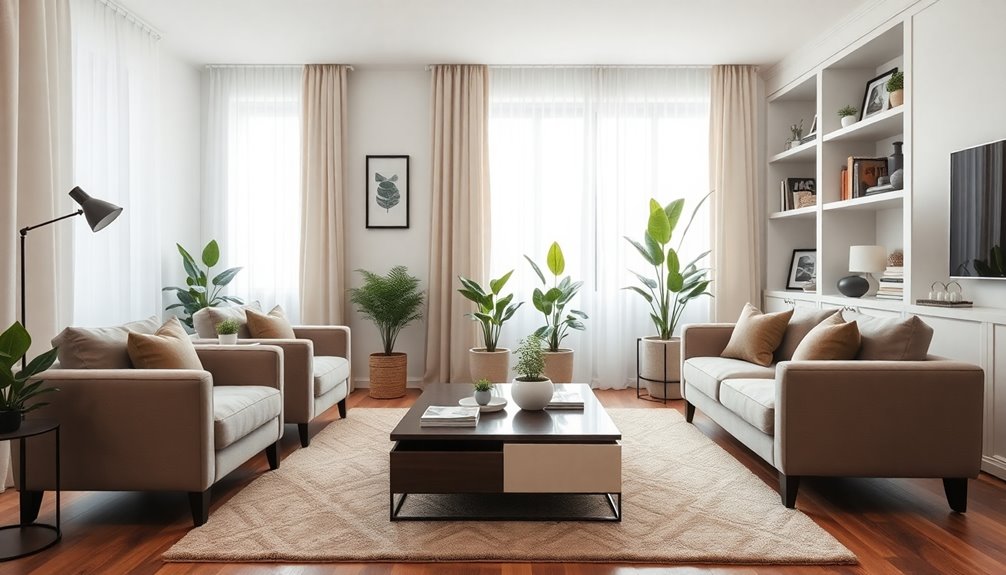
Maintaining clear and well-lit spaces is just the first step in ensuring a safe environment for seniors; smart storage solutions play an essential role in minimizing clutter.
By incorporating these strategies, you can improve organization and create a cozy living space that's accessible:
- Install easy-to-open drawers and cabinets to reduce clutter and frustration.
- Utilize open shelving for frequently used items, promoting independence and ease of access.
- Consider nesting tables and built-in shelves to maximize space stylishly.
- Designate areas for personal accessories and decorative elements, allowing meaningful displays without overcrowding.
These smart storage solutions not only keep your home tidy but also help minimize obstacles, creating a safer environment for everyone. Additionally, implementing home improvement strategies can further enhance the overall quality of life for seniors.
Choosing Non-Slip Flooring for Safety
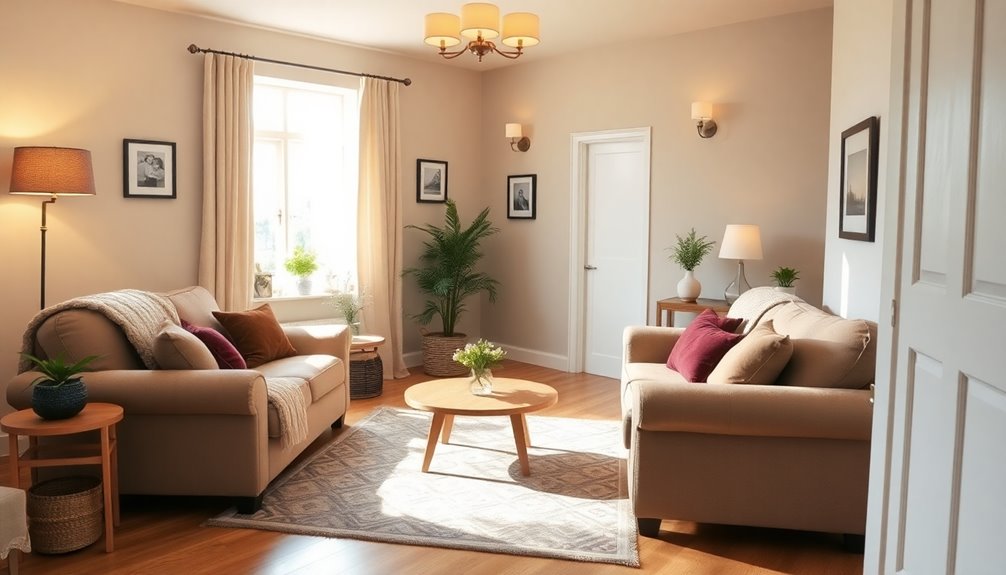
What could be more important than ensuring a safe living space for seniors? Choosing non-slip flooring is essential for fall safety in a cozy and stylish elderly home.
Opt for materials like vinyl, low-pile carpets, or treated hardwood to reduce the risk of slips and falls. In moisture-prone areas, pebble-tiled floors provide natural slip resistance while enhancing aesthetics.
If new flooring isn't an option, consider using perforated anti-slip rubber mats for immediate safety. Make sure connections between different flooring types are smooth to prevent tripping hazards.
Regular maintenance, including cleaning and resealing, keeps your slip-resistant surfaces effective, ensuring a senior-friendly living environment that prioritizes safety without sacrificing style.
Personalizing Spaces With Meaningful Decor
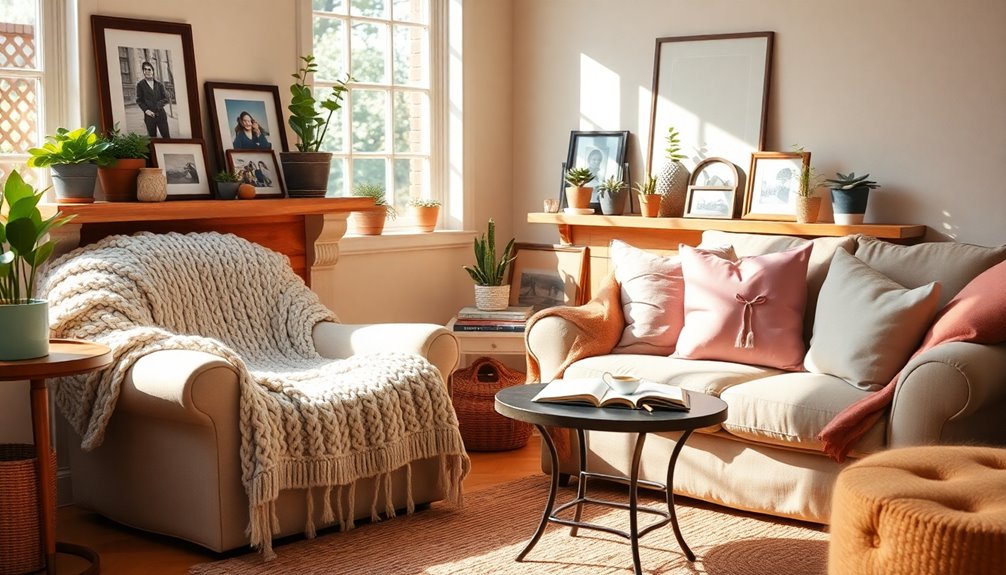
Personalizing your space with cherished family photos and sentimental art pieces can transform your home into a haven filled with memories.
Displaying personal heirlooms adds a unique touch that tells your story and creates a deeper connection to your environment.
This thoughtful decor not only enhances the aesthetic but also fosters a sense of belonging and comfort.
Cherished Family Photos
Cherished family photos can transform an elderly home into a warm and inviting space, filled with memories that spark joy and connection.
By incorporating these personal touches, you create a comfortable living space that reflects your unique story. Here are some tips to enhance your environment:
- Display photos at eye level for easier viewing and connection.
- Use frames that complement your decor to harmonize the space and highlight personal history.
- Create a dedicated gallery wall that not only decorates the room but also serves as a conversation starter.
- Rotate photos periodically to keep the atmosphere fresh and encourage storytelling.
These simple additions can foster safety and ease while making your home truly yours.
Sentimental Art Pieces
Art has a unique way of making a space feel like home, especially when it carries personal significance. Incorporating sentimental art pieces, like family photos or cherished artwork, fosters a sense of belonging and enhances emotional well-being in your living space.
These meaningful decor items create a personalized environment that reflects your unique story and experiences. Thoughtful arrangement of your art can serve as conversation starters, promoting social interaction with visitors and caregivers.
To guarantee you maintain your autonomy, choose lightweight frames that are easy to handle. Strategic placement of these pieces at eye level and near seating areas optimizes visibility and enjoyment, contributing to the overall comfort of your living spaces.
Personal Heirloom Displays
Incorporating personal heirlooms into your home decor can create a warm and inviting atmosphere that resonates with your unique history.
Personal heirloom displays evoke cherished memories, enhancing your emotional well-being. By thoughtfully arranging family photos and meaningful items in accessible areas, you'll make daily connections to your personal history.
Here are some tips to create cozy and stylish spaces:
- Use well-lit areas to highlight heirlooms and foster a warm ambiance.
- Choose shelves or shadow boxes to minimize clutter while showcasing meaningful items.
- Curate a mix of heirlooms that reflect your individual story and preferences.
- Rotate displays occasionally to keep your decor fresh and engaging.
Embrace these personal touches, and watch your space transform into an inviting and personalized haven.
Incorporating Technology for Convenience and Security
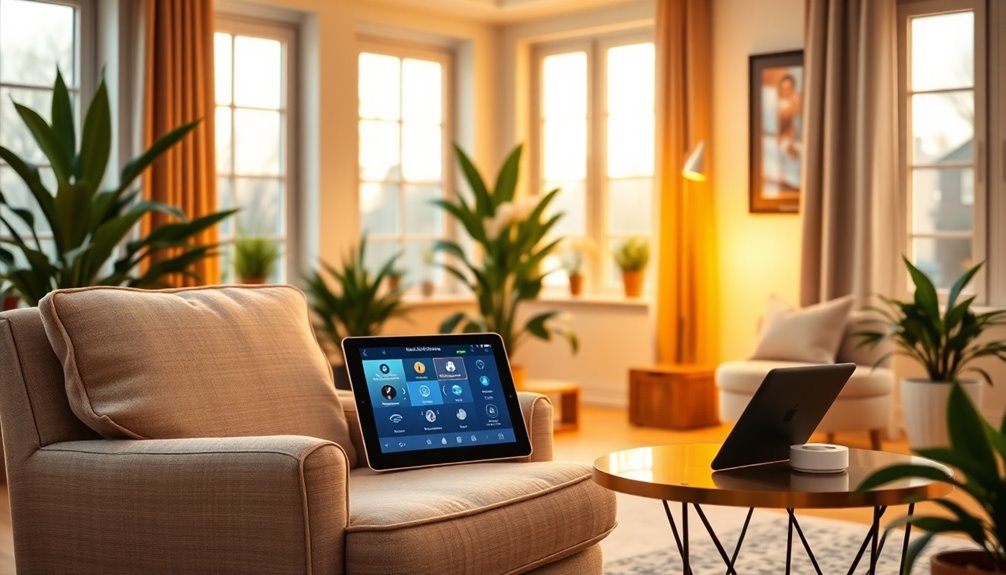
As you look to enhance the comfort and safety of an elderly home, integrating technology can play an essential role in promoting independence and security. Embracing a smart home setup allows seniors to control automated lighting, temperature, and security systems through voice-activated assistants, enhancing convenience.
Motion-sensor lights guarantee illumination in dark areas, reducing fall risks at night. Smart locks and video doorbells provide added security, letting seniors manage access to their homes and monitor visitors without opening the door.
Health monitoring devices, including wearables, track critical signs, offering peace of mind to both seniors and caregivers. Additionally, medication management apps remind seniors to take their medications, supporting adherence to health regimens and further fostering their independence.
Effective Use of Color and Texture
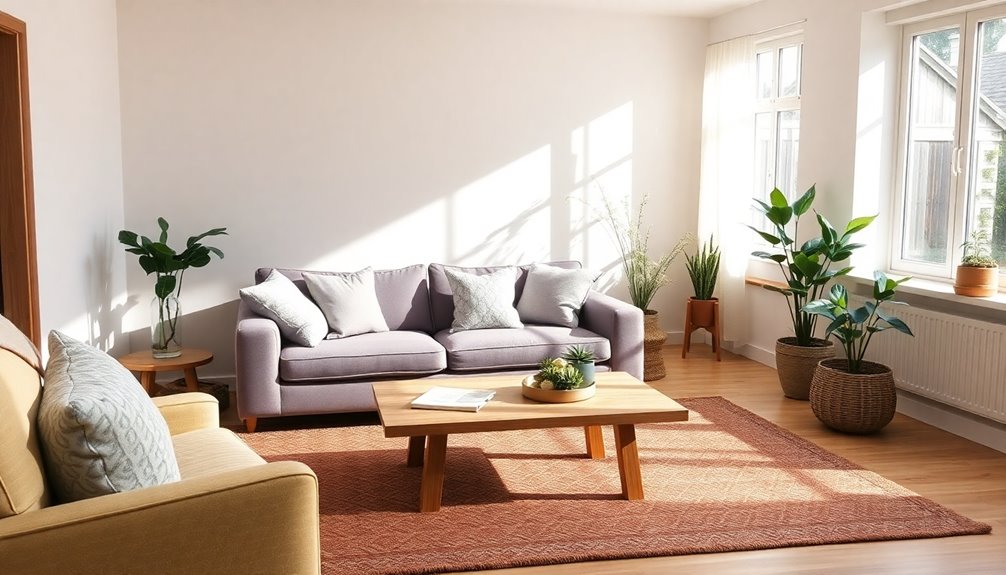
Creating a soothing environment for elderly residents hinges on the effective use of color and texture. By selecting calming colors like soft blues, greens, and neutrals, you can reduce anxiety and promote relaxation.
Incorporate contrasting colors for essential objects to enhance visual perception, aiding those with visual impairments.
Consider these tips for your design:
- Use warm tones to evoke feelings of comfort and warmth.
- Opt for soft, durable fabrics on furniture for tactile stimulation.
- Mix smooth and textured surfaces to create inviting spaces.
- Provide sensory variety to engage residents and make the environment more interesting.
With the right blend of color and texture, you can transform spaces into cozy, welcoming havens for seniors.
Enhancing Mood With Natural Elements

Bringing natural elements into an elderly home can greatly elevate the mood and overall well-being of residents. Utilize natural light by positioning seating near windows, creating a positive atmosphere.
Incorporate houseplants to enhance mood while improving air quality, fostering a healthier environment. Choose calming color palettes inspired by nature, like soft greens and blues, to evoke tranquility and comfort.
Adding natural textures through materials such as wood, stone, and soft fabrics can create a soothing ambiance, reducing stress and anxiety.
Finally, include artwork or photographs of natural landscapes to foster a connection to the outdoors, enhancing emotional well-being and encouraging relaxation.
Together, these elements help create a comfortable home for seniors, promoting a happier, more peaceful living space.
Planning for Future Mobility Needs
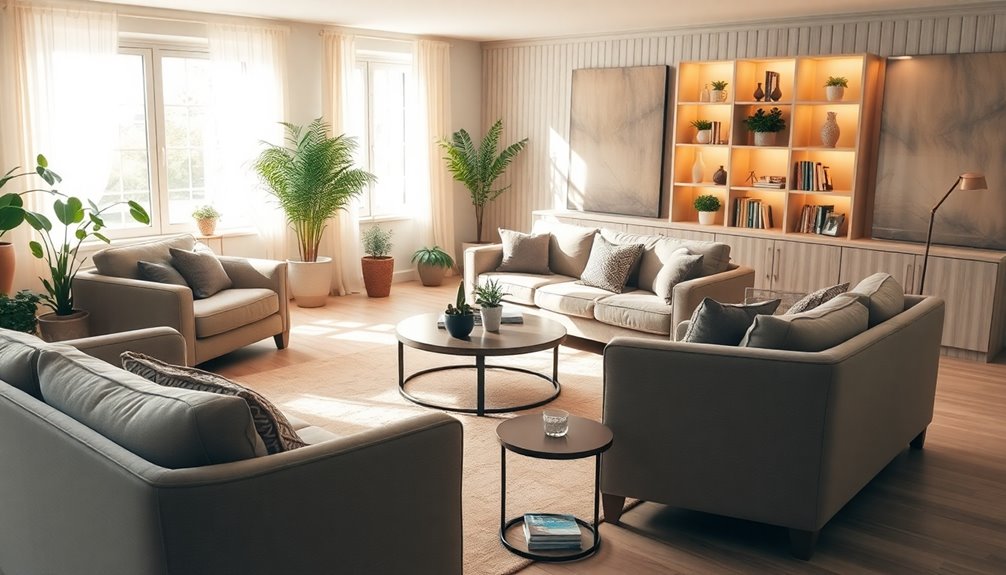
When planning for future mobility needs, it's essential to reflect on how changes in physical abilities can impact daily life.
You want to guarantee that your home remains safe and functional as you age. Here are some important considerations:
- Doorways: Make sure they're at least 32 inches wide for easy access with walkers or wheelchairs.
- Adjustable furniture: Look for beds and chairs that adapt to your changing needs.
- Non-slip flooring: Choose low-pile carpets or vinyl to reduce fall risks.
- Clear pathways: Arrange furniture to create unobstructed areas for maneuverability.
Additionally, installing grab bars in bathrooms and hallways will provide essential support, promoting your independence as mobility needs evolve.
Frequently Asked Questions
What Is the 70 30 Rule in Interior Design?
The 70/30 rule in interior design suggests you dedicate 70% of a room to a dominant color or theme, while the remaining 30% should feature accent colors or elements.
This balance creates a harmonious space, with the dominant color providing a cohesive backdrop.
For instance, you might choose neutral walls and large furniture, then add vibrant throw pillows or artwork to inject personality.
Feel free to adapt this rule to fit your personal style!
How to Design a Home for the Elderly?
Designing a home for the elderly isn't just about aesthetics; it's about creating a safe haven.
You'll want to guarantee doorways are wide enough for walkers and wheelchairs, while choosing ergonomic furniture that offers support.
Juxtaposing comfort with functionality, implement smart storage solutions to keep clutter at bay.
Incorporate plenty of lighting to enhance visibility, and don't forget essential safety features like grab bars and non-slip flooring to prevent accidents.
What Is the Coziest Interior Design Style?
The coziest interior design style focuses on creating a warm and inviting atmosphere.
You'll want to use soft color palettes like muted greens and gentle pastels. Incorporate plush fabrics and layered textures, such as knitted throws and soft rugs, to enhance comfort.
Personal items, like family photos, add warmth and familiarity.
Finally, choose layered lighting that casts a soft glow, and opt for multifunctional furniture to keep your space clutter-free and welcoming.
What Are the 7 Basics of Interior Design?
Imagine walking into a room where the furniture is perfectly arranged, allowing for easy movement.
The seven basics of interior design include space, line, form, color, texture, pattern, and light. You'll want to think about how each element interacts.
For instance, using a soft blue color can create a calming atmosphere, while varied textures, like a plush rug, add comfort.
Conclusion
So, if you're aiming to transform your elderly loved one's home into a cozy haven, remember: comfort and safety aren't just for the young and spry! Forget about bland institutional vibes; we're going for chic and secure. Embrace the chaos of life with smart storage and non-slip flooring, because who needs a broken hip over a rogue rug? Add a splash of color, toss in some tech, and voilà—your home's now a stylish sanctuary, perfect for sipping tea or plotting world domination!
